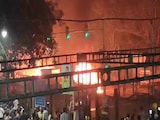On a day that a dense blanket of smog enveloped Delhi and choked the city, official air quality updates abruptly halted midday, leaving millions in the dark about the severity of the crisis.
The disruption came just 24 hours after widespread protests erupted across the capital, with demonstrators accusing authorities of manipulating pollution figures and eroding public trust in the Delhi government. On Monday, the Air Quality Index (AQI) readings ceased entirely after noon, even as the sky remained obscured and roads turned treacherous under low visibility.
The Central Pollution Control Board (CPCB) last reported an AQI of 345 at 12.15 pm via its Sameer app and official website, before the feed went offline. Authorities attributed the blackout to a technical fault, promising a resolution by later in the day.
In response, the Commission for Air Quality Management (CAQM) activated its sub-committee on the Graded Response Action Plan (GRAP) for an urgent review, emphasising ongoing vigilance over the deteriorating conditions.
Sunday had marked a grim peak, with the AQI climbing to 391 by 10 am - the worst level recorded this season so far. Despite the visible deterioration on Monday, including heavy traffic crawling through fog-like pollution on highways such as NH-9 near Ghaziabad, no further data emerged to guide residents or enforce anti-pollution measures.
This incident echoes previous outages earlier in the season. On October 26, AQI updates stalled for about 11 hours from midday until late night, and the CPCB's standard 4 pm national bulletin was delayed until 10.45 pm. The following day saw another 12-hour gap, with officials claiming full resolution by October 27.
The CAQM conducted a detailed evaluation on Sunday afternoon but opted against escalating to GRAP Stage 3 restrictions for the National Capital Region (NCR), pointing to a downward trend in the 24-hour average and absence of severe forecasts. Stages 1 and 2 of the emergency protocol remain active.













